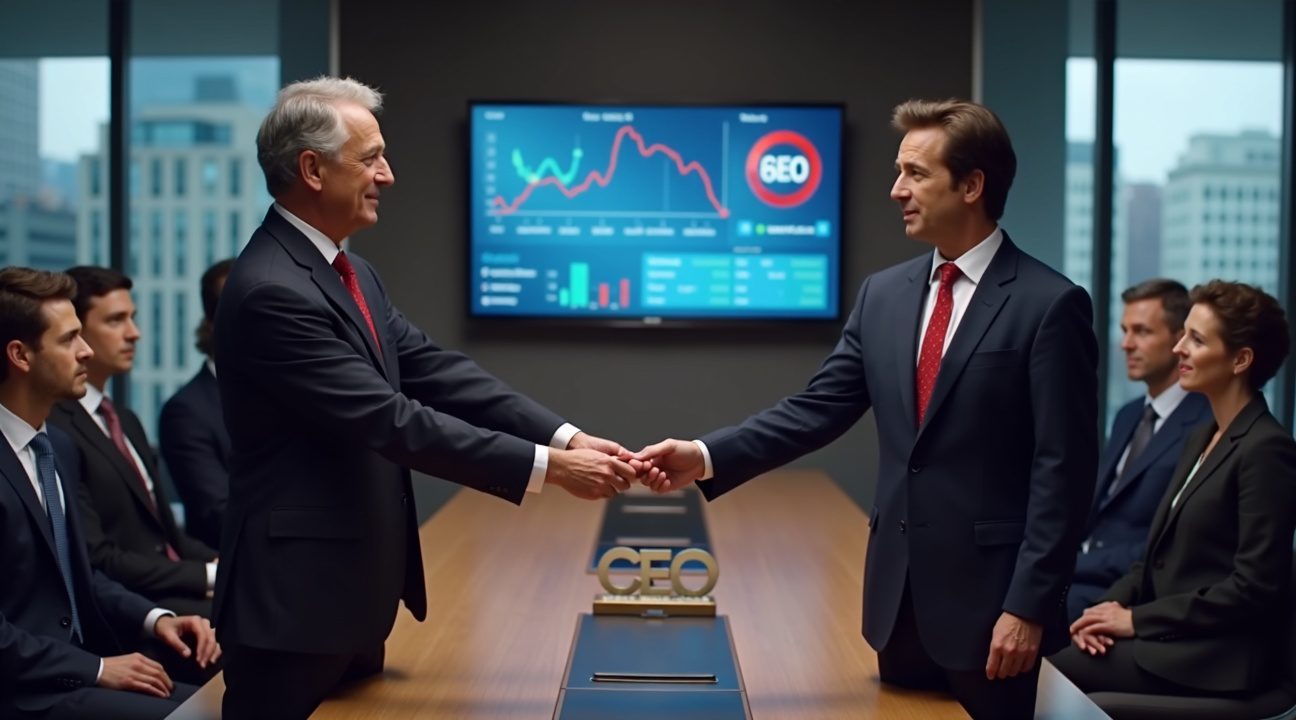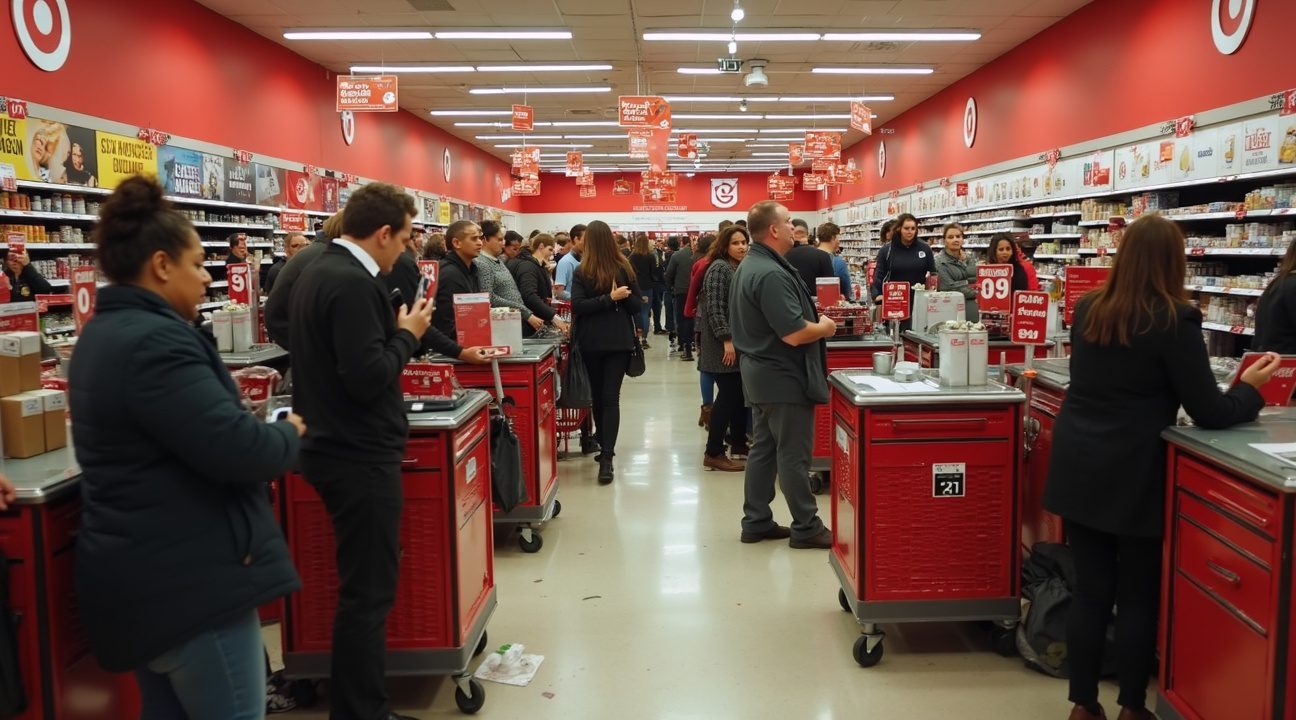Target Corporation stands at a pivotal moment as current CEO Brian Cornell prepares to step down after more than a decade of leadership, handing the reins to Chief Operating Officer Michael Fiddelke amid mounting financial and operational challenges.
Leadership Transition on the Horizon
Brian Cornell will officially transition to the role of executive chair in February 2026, ending his 11-year tenure as CEO of Target. Taking his place is Michael Fiddelke, the current COO, who will face a series of headwinds as he steps into the leadership role. These include declining store traffic, financial underperformance, and intensifying competition in the retail market.
Financial Snapshot: A Downward Trend
Target’s latest financial figures reflect an urgent need for transformation:
- Comparable sales have fallen 1.9% year-over-year
- Store sales declined by 3.2%, indicating reduced foot traffic
- Net income plummeted 21% compared to the same quarter last year
- Forward guidance predicts continued low-single-digit sales declines through 2025
Market Share Erosion and Competitive Pressure
As Walmart and discount retailers such as TJ Maxx strengthen their positions, Target is losing market share in key product categories. Alarmingly, it has managed to maintain or gain share in only 14 out of 35 retail categories. Customers seeking value are increasingly shifting toward competitors who offer more consistent pricing, better product availability, and enhanced in-store services.
Operational Challenges and Brand Perception
Internal inefficiencies have further weakened Target’s standing. Among the core issues:
- Widespread inventory shortages have led to stockouts, disappointing thousands of shoppers
- Long checkout wait times have diminished the in-store customer experience
- Poor store maintenance has drawn criticism and impacted brand image
- Brand controversies have alienated key consumer demographics, adding another layer to Target’s woes
Turnaround Strategy from the Incoming CEO
Michael Fiddelke has laid out a vision to steer Target through recovery and renewal. His three-point action plan includes:
- Reclaiming merchandising leadership through promotions and private-label innovation
- Enhancing in-store experiences via redesigns and employee engagement improvements
- Modernizing operations with robust investments in digital infrastructure across all 1,980 U.S. store locations
Only time will tell if these efforts will be enough to return Target to its once-celebrated status as the epitome of “cheap chic.” For more insights on Target’s future steps, visit their official corporate site.
Brian Cornell Steps Down as Target CEO After 11 Years, Michael Fiddelke Named Successor
Target Corporation announced a significant leadership transition as Brian Cornell prepares to step down from his role as Chief Executive Officer after an 11-year tenure marked by both strategic successes and recent challenges. Cornell, who took the helm in 2014, will transition to executive chair effective February 1, 2026, as the retail giant grapples with persistent sales declines and mounting pressure from investors.
Michael Fiddelke, Target’s current Chief Operating Officer, will assume the CEO position in what represents a clear internal succession strategy. Fiddelke brings extensive institutional knowledge to the role, having spent two decades with the company across various leadership positions. His deep understanding of Target’s operations and culture positions him to potentially address the operational challenges that have contributed to the company’s recent struggles.
Market Reaction and Analyst Concerns
The announcement triggered immediate market volatility, with Target’s stock price dropping more than 10% in pre-market trading following both the leadership change and earnings release. This sharp decline reflects investor uncertainty about the company’s strategic direction and whether an internal appointment can deliver the transformational changes many believe are necessary.
Investment analysts have expressed mixed reactions to Fiddelke’s appointment, with several questioning whether promoting from within represents the best approach for addressing Target’s systemic challenges. Many in the investment community had anticipated and preferred an external hire, believing that fresh leadership from outside the organization could bring new perspectives and more aggressive reform strategies. Similar leadership transitions have occurred across the industry, as seen when Netflix experienced leadership changes during challenging periods.
Internal vs. External Leadership Debate
The decision to promote Fiddelke rather than recruit external talent highlights a fundamental strategic choice facing Target’s board of directors. Proponents of internal succession argue that Fiddelke’s extensive experience provides continuity and eliminates the learning curve that external candidates typically face. His familiarity with Target’s supply chain, store operations, and corporate culture could enable faster implementation of necessary changes.
However, critics contend that Target’s current challenges require more than operational refinements. They argue that the company needs wholesale strategic transformation that might be better achieved through external leadership bringing different industry perspectives and proven turnaround experience. This debate mirrors similar discussions that have occurred when other major corporations faced performance pressures, including situations where companies implemented significant restructuring under new leadership.
The broader skepticism about Target’s ability to transform from within reflects deeper concerns about the retail environment and competitive pressures facing traditional brick-and-mortar retailers. Investors increasingly demand rapid adaptation to changing consumer behaviors, enhanced digital capabilities, and more efficient cost structures.
Cornell’s transition to executive chair suggests he’ll maintain some influence over strategic direction while allowing Fiddelke operational control. This arrangement could provide stability during the transition period but may also limit the extent of potential changes if investors and analysts believe more dramatic shifts are necessary.
The timing of this leadership announcement, coinciding with disappointing earnings results, underscores the urgency facing Target’s management team. Fiddelke will inherit significant challenges including declining same-store sales, margin pressure from competitive pricing, and the ongoing need to optimize Target’s omnichannel retail strategy.
Market watchers will closely monitor Fiddelke’s initial strategic announcements and quarterly performance metrics to assess whether internal promotion can deliver the operational improvements and strategic repositioning that Target requires to restore investor confidence and return to sustainable growth.

Target’s Financial Struggles Continue with Declining Sales and Profits
Target’s latest quarterly results paint a concerning picture for the retail giant, with comparable sales declining 1.9% year-over-year in the most recent quarter. Store sales experienced an even steeper drop of 3.2%, highlighting the challenges facing traditional brick-and-mortar retail operations. Digital sales provided some relief, rising 4.3%, but this growth couldn’t offset the broader decline across Target’s retail network.
The financial pressure extends beyond sales figures, with net income plummeting 21% in the quarter ending August 2. This dramatic profit decline underscores the depth of Target’s current operational challenges and suggests that cost-cutting measures haven’t been sufficient to maintain profitability levels. Similar leadership transitions have occurred across the retail industry, with other companies experiencing comparable pressures when executives step down during difficult periods.
Despite the disappointing performance metrics, Target’s Q2 2025 revenue of $25.2 billion managed to exceed Wall Street expectations, even though it represented nearly a 1% decline from the previous year. This revenue figure demonstrates that while the company continues to generate substantial income, the trajectory remains concerning for investors and stakeholders. The ability to beat analyst projections provides some cushion, but doesn’t address the underlying trend of declining consumer engagement with Target’s offerings.
Projected Sales Outlook Remains Challenging
Target’s management has set expectations for continued difficulty ahead, projecting a low-single-digit decline in sales for 2025. This forecast indicates that company leadership doesn’t anticipate a quick turnaround, suggesting deeper structural issues within the business model or market positioning. The projection also reflects the broader retail environment, where companies face increasing competition from e-commerce platforms and changing consumer spending patterns.
Corporate restructuring often accompanies such financial pressures, and Target’s situation mirrors challenges faced by other major companies. Recent months have seen numerous organizations making difficult decisions, with some implementing significant workforce reductions to address declining revenues and maintain operational efficiency.
The digital sales growth of 4.3% represents one bright spot in Target’s performance, demonstrating that the company’s online platform continues to attract customers. However, this growth rate falls short of compensating for the substantial losses in physical store sales. The disparity between digital and in-store performance suggests that Target’s omnichannel strategy requires significant refinement to better integrate online and offline shopping experiences.
Profitability concerns extend beyond simple revenue calculations, as the 21% drop in net income indicates that Target’s cost structure may not be properly aligned with current revenue levels. Operating expenses, inventory management, and supply chain costs could all be contributing factors to the margin compression the company is experiencing.
The retail landscape continues to evolve rapidly, with consumer preferences shifting and economic uncertainties affecting spending patterns. Target’s financial struggles reflect broader industry challenges, but the magnitude of the declines suggests company-specific issues that require strategic attention. Leadership changes often accompany such periods of financial difficulty, as boards and stakeholders seek fresh perspectives on addressing operational challenges.
Market analysts will closely monitor Target’s upcoming quarters to determine whether these declines represent a temporary adjustment or signal deeper, more persistent problems with the company’s market position. The combination of declining store sales, modest digital growth, and significant profit erosion creates a complex challenge that will require comprehensive strategic responses to address effectively.
Losing Ground to Walmart and Discount Retailers in Competitive Market
Target’s recent performance reveals a troubling trend as the retailer continues to lose market share to major competitors. The company managed to gain or maintain share in only 14 out of 35 product categories this quarter, a stark indicator of its weakening position across multiple retail segments.
Walmart has emerged as a primary beneficiary of Target’s struggles, capitalizing on consumers’ heightened focus on value shopping. The retail giant’s aggressive pricing strategies and expanded product offerings have attracted budget-conscious shoppers who previously viewed Target as their preferred destination. This shift becomes particularly evident during economic uncertainty when household budgets face increased pressure.
Discount retailers like TJ Maxx have also carved away significant portions of Target’s customer base. These off-price retailers appeal to shoppers seeking brand-name merchandise at substantially reduced costs, offering an alternative that combines quality with affordability. The treasure hunt shopping experience these stores provide has proven especially attractive to consumers looking for both value and variety in their retail choices.
The Identity Crisis Behind Market Share Erosion
Analysts point to a fundamental identity crisis that has undermined Target’s competitive position. The retailer’s “cheap chic” positioning, once considered a defining brand strength, has become increasingly difficult to maintain in today’s market environment. This concept, which successfully differentiated Target from pure discount retailers and traditional department stores, now appears outdated as consumer priorities have shifted dramatically.
Several factors contribute to this identity challenge:
- Rising costs have forced Target to increase prices on many items, eroding its value proposition
- Supply chain disruptions have affected product availability and quality consistency
- Competition from online retailers has changed consumer expectations for convenience and pricing
- Economic pressures have made shoppers more price-sensitive across all income levels
The struggle to maintain this cheap chic identity reflects broader challenges within the retail industry. Companies that once thrived on positioning themselves between high-end and discount retailers now find themselves squeezed by competitors who excel in specific areas. Similar challenges have affected other retail leaders, as seen when the founder of Netflix steps down amid changing market conditions.
Target’s attempts to revitalize its brand through exclusive partnerships and designer collaborations haven’t generated the customer traffic and sales growth the company anticipated. These initiatives, while generating initial buzz, have failed to translate into sustained competitive advantages against retailers focused purely on price or convenience.
The company’s troubles extend beyond simple pricing issues. Target’s store experience, once considered superior to discount competitors, has lost some of its appeal as other retailers have improved their offerings. Walmart’s store renovations and expanded grocery sections have made it a more attractive one-stop shopping destination for families seeking both convenience and value.
Digital commerce has further complicated Target’s position. While the company has invested heavily in online capabilities and same-day delivery services, it faces intense competition from Amazon and other e-commerce platforms that can offer lower prices and faster delivery options. This digital pressure has forced Target to increase its technology spending while simultaneously dealing with declining profit margins.
The current market environment favors retailers with clear value propositions. Walmart’s everyday low prices and TJ Maxx’s discounted brand names offer straightforward benefits that resonate with cost-conscious consumers. Target’s more nuanced positioning requires customers to balance style, quality, and price considerations, a complex decision-making process that many shoppers now prefer to avoid.
Regional variations in Target’s performance also highlight the company’s challenges. Markets with higher concentrations of Walmart stores and off-price retailers have shown particularly steep declines in Target’s market share. This geographic pattern suggests that direct competition, rather than broader economic factors alone, drives much of the company’s current difficulties.
Corporate restructuring across various industries has become increasingly common as companies adapt to changing market conditions. Just as Microsoft plans significant workforce reductions to streamline operations, Target may need to fundamentally reassess its market positioning and operational strategies to regain competitive ground against its more focused competitors.
Operational Problems Drive Customer Frustration and Store Issues
Target’s operational challenges have created a cascade of customer service issues that directly impact the shopping experience. Persistent inventory shortages mean customers frequently encounter empty shelves where popular items should be, forcing them to make additional trips or abandon purchases altogether. Register wait times have stretched beyond acceptable limits during peak hours, with insufficient staffing creating bottlenecks that test even loyal customers’ patience.
Store Environment and Operational Inefficiencies
The company’s stores have struggled to maintain the clean, organized appearance that once distinguished Target from competitors. Merchandise sits disheveled on shelves, aisles remain cluttered with restocking carts, and fitting rooms often stay locked or unmanned. These conditions reflect deeper staffing and training issues that compromise the brand’s premium positioning. When customers can’t find what they need or must wait extensively to complete purchases, they naturally gravitate toward competitors offering smoother experiences.
Current economic pressures have made consumers exceptionally value-conscious about both their money and time investments. Shoppers now scrutinize every aspect of their retail experience, from product availability to checkout efficiency. Target’s operational stumbles arrive at precisely the wrong moment, as customers have numerous alternatives including Amazon’s convenience, Walmart’s competitive pricing, and specialized retailers’ focused selections. The combination of frustrating in-store experiences and heightened consumer expectations has accelerated customer defection rates.
Brand Perception Challenges
Recent controversies surrounding product merchandising decisions have further complicated Target’s relationship with key customer segments. Social media-driven boycotts gained momentum among certain consumer groups, creating additional headwinds for sales performance. The retailer’s subsequent scaling back of diversity, equity, and inclusion initiatives has created tension with other customer demographics who viewed these programs as core brand values.
These perception challenges extend beyond single shopping trips to affect long-term brand loyalty. Corporate leadership decisions that once seemed routine now face intense scrutiny from multiple stakeholder groups. The retailer finds itself attempting to balance competing demands while operational problems continue undermining basic customer satisfaction metrics.
Store managers report increased difficulty maintaining service standards with reduced staff levels and higher employee turnover rates. Training programs have been compressed, leaving newer employees less prepared to handle complex customer situations or inventory management tasks. The result creates a self-reinforcing cycle where poor service leads to customer complaints, which increases staff stress and turnover, which further degrades service quality.
Target’s technology infrastructure hasn’t kept pace with operational demands either. Point-of-sale systems experience frequent glitches, mobile app integration remains inconsistent, and inventory tracking often fails to reflect real-time availability. These technical shortcomings compound physical operational problems and create additional friction points for increasingly impatient consumers.
The retailer’s struggles mirror broader challenges facing traditional department stores, but Target’s specific combination of operational inefficiencies and brand perception issues has proven particularly damaging. Companies like other major retailers have faced similar leadership transitions during difficult periods, highlighting how operational problems can accelerate executive changes.
Customer feedback surveys consistently highlight these operational pain points as primary reasons for shopping elsewhere. Comments frequently mention long lines, empty shelves, and unkempt stores as deal-breakers that override any pricing advantages or product selection benefits. The company’s inability to address these fundamental service issues has created vulnerability that competitors actively exploit through targeted marketing campaigns emphasizing their superior shopping experiences.
Supply chain disruptions have exacerbated existing operational weaknesses, but many of Target’s problems stem from internal management decisions rather than external factors. Staffing cuts implemented to protect margins have backfired by degrading the customer experience to unacceptable levels. Store maintenance budgets have been trimmed, creating the messy environments that now characterize many locations. These cost-cutting measures have proven counterproductive as they’ve driven away the very customers needed to generate revenue recovery.

New CEO Outlines Three-Point Strategy to Turn Around Target’s Performance
Incoming CEO Michael Fiddelke has developed a focused approach to address Target’s declining sales through three core priorities designed to restore the retailer’s competitive edge. His strategy emphasizes fundamental retail excellence while leveraging digital innovation to drive recovery.
Three Pillars of Target’s Turnaround Plan
Fiddelke’s comprehensive strategy centers on these key areas:
- Reclaiming merchandising authority and trendsetting leadership to differentiate Target from competitors
- Improving the in-store shopping experience by maintaining well-stocked shelves and clean retail environments
- Investing heavily in technology upgrades for both physical stores and supply chain operations
The new CEO brings valuable experience from overseeing Target’s acceleration office, a specialized division created to speed up strategic initiative implementation. This background positions him well to execute rapid changes needed to reverse the company’s sales decline. Digital sales performance offers encouraging signs for the recovery plan, with same-day delivery services showing particularly strong growth metrics.
Fiddelke’s emphasis on merchandising leadership reflects Target’s historical strength in offering unique, trend-forward products that attract shoppers. Similar to how other retail leaders have stepped back to refocus their brands, Target aims to recapture its distinctive market position through better product curation and exclusive partnerships.
The operational improvements focus on addressing basic retail fundamentals that directly impact customer satisfaction. Empty shelves and poor store conditions have contributed to shopper frustration, making these immediate priorities for the new leadership team. Technology investments will support both customer-facing improvements and backend efficiency gains across Target’s extensive store network.
Supply chain enhancements represent a critical component of the recovery strategy, particularly given recent inventory challenges that have plagued many retailers. Digital integration remains central to Fiddelke’s vision, building on existing momentum in online sales channels and delivery services that have shown resilience during Target’s difficult period.
The acceleration office concept demonstrates Fiddelke’s commitment to rapid execution rather than prolonged strategic planning phases. This approach mirrors successful turnaround efforts where major companies have streamlined operations to achieve faster results. Target’s focus on technology-enabled solutions positions the retailer to compete more effectively with both traditional competitors and e-commerce giants.
Early indicators suggest that Target’s digital transformation efforts have gained traction, providing a foundation for broader recovery initiatives. The combination of improved physical retail operations with enhanced digital capabilities creates multiple pathways for customer engagement and sales growth.
Scale of Challenge Ahead for Target’s Transformation Efforts
Target’s leadership transition occurs against the backdrop of managing nearly 1,980 US stores, a massive retail footprint that amplifies every strategic decision and operational challenge. The sheer scale of this operation means that even small changes in consumer behavior or market conditions ripple through thousands of locations, affecting millions of transactions daily.
The incoming leadership faces the complex task of reinventing a retail giant while maintaining day-to-day operations across this extensive network. Each store location represents unique local market dynamics, staffing considerations, and inventory management challenges that must be addressed holistically. This operational complexity extends beyond physical locations to encompass supply chain logistics, digital integration, and the seamless coordination between online and brick-and-mortar experiences.
Critical Areas Requiring Immediate Attention
The transformation efforts must address several interconnected challenges that span the entire organization:
- Profitability restoration across all store formats and geographic markets
- Brand repositioning to differentiate from competitors like Walmart and Amazon
- Supply chain optimization to reduce costs while maintaining product availability
- Technology infrastructure upgrades to support omnichannel retail experiences
- Workforce development and retention strategies during periods of change
- Customer loyalty program enhancement to drive repeat business
Market analysts view this leadership change as a pivotal moment similar to other major retail transformations. The pressure extends beyond simply reversing declining sales figures to fundamentally reimagining Target’s value proposition in an increasingly competitive retail landscape. Much like when the founder of Netflix steps down, such transitions often signal deeper strategic shifts within organizations.
The scale of Target’s physical presence creates both opportunities and obstacles for transformation initiatives. While the extensive store network provides valuable real estate assets and customer touchpoints, it also represents significant fixed costs and operational inertia that can slow adaptation to changing consumer preferences. The new leadership must balance the need for rapid change with the practical realities of managing such a large retail operation.
Consumer expectations continue evolving rapidly, particularly around digital experiences, same-day delivery, and personalized shopping. Target’s transformation must address these expectations while leveraging its physical store advantage over pure e-commerce competitors. The company’s ability to execute this transformation effectively will determine whether it can regain market share and restore investor confidence in its long-term viability.

Sources:
(blank)


